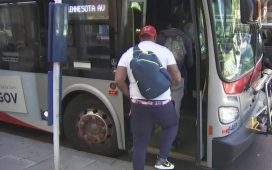BRYAN, Texas (KBTX) – The Texas A&M Transportation Institute (TTI) is sounding the alarm on a roadway safety concern that policymakers need to pay attention to.
Electric vehicles (EVs) have been gaining popularity with some high-tech capabilities, but when it comes to a crash, researchers have suggested that current infrastructure may not make the cut to save lives.
TTI Agency Director, Greg Winfree, told KBTX one piece of this was noticing EVs weigh 20 to 30% more than their gas-powered counterparts.
“Electric vehicles present somewhat of a physics challenge,” Winfree began. “We had a suspicion, when vehicles that were electrified first started to come onto the market, that they may have issues with respect to how they interacted with roadside infrastructure that is deployed around the country.”
It’s not only the weight of the vehicle, TTI said. The battery used to power EVs creates a lower center of gravity and the front is a storage space instead of an engine compartment. These factors can all be seen in a crash test conducted at the RELLIS Campus, released this summer, showing a Tesla Model 3 smashing through a guardrail with the same force used in successful crash tests in the past.
“There were a lot of jaws that hit the ground as a result of that crash test,” said Winfree.
The crash test led Winfree to propose just how important guardrails are to saving lives. According to the Texas Strategic Highway Safety Plan, roadway and lane departure crashes are the most common type of crash in Texas and are associated with 40% of roadway fatalities.
“It’s safe to say over the years since their deployment, that we’ve saved tens of thousands of lives globally with respect to how guardrails protect roadway occupants, particularly for a vehicle in off-the-roadway crashes,” he detailed.
This is why TTI says policymakers need to be paying attention and hopefully, changes will be coming.
“We know that these initial tests for electrified vehicle crashes have shown us that there’s an issue,” added Winfree. “How do we either strengthen the roadside infrastructure we have now, or how do we design the next generation of technologies that will protect all vehicles?”
Throughout history, TTI said roadway infrastructure has been updated often to accommodate changes in cars, but this crash test has produced some of the most dramatic results it’s ever seen.
This is research happening at several Universities including the University of Nebraska.
Copyright 2024 KBTX. All rights reserved.




